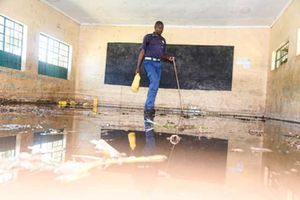
Aerial view of trenches of silted Lake Magadi in Kajiado County on December 9, 2020.
| Robert Gichira | Nation Media GroupNews
Premium
Human activities and mega projects are driving Lake Magadi to extinction
The parched and bare ground in Ndupa in Kajiado County does nothing to ease the heat from the scorching sun above. Dust rises at the mildest blow of the wind.
At the horizon, the dust-pattered shrubs that once dotted a shoreline stand few and far between, blinding the higher lands of Suswa in Narok County.
It was not always like this, Aramato ole Samdala, 40, says. Throughout his childhood years, the ground he stands on was Kisamis River’s mouth to Lake Magadi. A few metres away, the communities would draw drinking water from the river before it met the salty lake. “It was also a watering point for animals and the only source of water for domestic use,” Samdala remembers.
Gradually, gravel, sand, silt, clay and other sediments were deposited into the lake and in no time, the entire section of the lake that lies in the village was covered in soil.
“Since 2005, the amount of soil that was being swept into this place from the highland in Suswa and Nairegie Enkare in Narok was so high, and it piled up at least a metre high every time it rained. Many people have been forced to move out of this area. Neighbours I have known since I was born have gone!” he says.

Ole Sammy Amudala walks on the dry part of Lake Magadi in Kajiado County on December 9, 2020.
Silt
The silt has occupied up to 20 square kilometres, which accounts for 30 per cent of Lake Magadi, affecting solid sodium carbonate (trona) mining undertaken by the TATA Chemicals Magadi Ltd. The purity of the available trona has also been reduced by at least five per cent, according to an analysis scientists conducted in October.
The company blames the infrastructure development activities upstream, including the construction of the Mai Mahiu-Narok Road, the Lake Magadi geographical location, poor farm management upstream and land degradation, among others, for the siltation in the lake.
“The construction of the Mai Mahiu-Narok Road, caused all the water that used to pool around Duka Moja area to be channelled through closed box culverts, as drainage for the road, this caused serious erosion and deep gullies as a result,
“Also, the construction of the second phase of SGR (standard gauge railway) within the ecosystem has become the biggest contributor to the siltation of Lake Magadi through Kisamis seasonal River. The SGR has also turned its drainage into the Kisamis Seasonal River, as a result, huge amounts of silt are being deposited into the Lake Magadi,” says TATA Chemicals Corporate Affairs and Community Development Manager Francis Sakimpa.

The alkali deposits at Lake Magadi which are used by TATA Chemicals Magadi Ltd to produce both soda ash and common salt.
Suswa Hills floods
The location of Lake Magadi, which lies 641m above sea level against Suswa Hills at 2,100m above sea level, is also believed to be a contributor to the siltation because the floodwaters from the Suswa Hills ecosystem easily drain into Lake Magadi. The lake is the southernmost lake in the Rift Valley, lying in a catchment of faulted volcanic rocks, north of Tanzania’s Lake Natron.
Upstream in Nairegie Enkare, Narok, the volcanic soil, which is loose and porous is easily be washed away by rainwater, forming deep gullies. This, coupled with poor farm management, causes the water to erode all the soil into Kisamis seasonal River to Lake Magadi during the rainy season.
“Charcoal burning and overgrazing are also very rampant around Mosiro and Oldepe, which are within the ecosystem. This is a big contributor to erosion into Lake Magadi,” says Mr Sakimpa.
Apart from affecting the quality of trona, TATA Chemicals says the 8,000 metric tonnes of soil per storm deposited into Lake Magadi for the past 15 years have negative impacts of constraining dredge operations, which in turn affects the company’s operations and profitability.
The company had to construct dykes to divert the Kisamis River in Entashata Olasit, at the northern arm of Lake Magadi, to prevent the silt from entering the lake. Its amount was too huge, threatening to cover the entire lake. This is after the gabions they built at the mouth of the river failed to reduce the erosion. The construction of dykes did little to manage floods at the lake.
Surface runoffs
Scientists, who spoke to the Nation, do not doubt the cause siltation in Lake Magadi — farming activities and infrastructure development in the upper and middle catchment areas of River Kisamis, contributing to huge surface runoffs and environmental degradation.
“Lake Magadi lies in the lowest part of the Rift Valley, and the area itself does not receive a lot of rain. When it rains upstream, all the water is drained to the plains of Magadi, and it gets worse because the land in the catchment area has been degraded and the soil is eroded in huge volumes,” says Simeon Onywere, an associate professor at the Department of Environmental Planning and Management at the Kenyatta University.
Prof Onywere says the large-scale sand harvesting around Kedong and Suswa in Nakuru and Narok has fuelled soil erosion.
The upper catchment covers Keekonyokie and Suswa wards of Narok East, and the middle catchment covers Mosiro in Narok-East, Ewuaso-oo Nkidongi and Mosiro wards of Kajiado West constituency.
Mr Samdala also blames the trench excavation around Kedong ranch, the construction of the Maai Mahiu-Narok Road and the SGR, which he says create deep gulleys, increasing silt flow into river Kisamis.
“We had a pump that served us water from the Kisamis River, but it was all covered in silt, now we depend on the Tata Chemicals to supply us with drinking water using their trucks because the remaining bit of Lake Magadi is impure. You cannot drink that water,” he says.
Upstream, communities in the middle catchment areas of River Kisamis were suffering due to crop destruction and soil erosion due to the diversion of the rivers in Narok to facilitate infrastructure development.
Families displaced
Several families have been displaced by the rise in water levels in Kikuyan in Narok, forcing them to relocate from their land. The flash floods have been leading to loss of lives and exposed sinkholes in Nairage Enkare.
Tata Chemicals is grossly affected due to the poor quality of trona, compromising its competitiveness in the international markets, hurting the company’s profitability.
This puts the livelihoods of at least 50,000 community members, 600 employees and the about Sh9 billion annual company’s contribution to the Kenyan economy at risk.
Apart from the negative impact on humans, the cichlid fish and some waterbird species, including flamingos face extinction. It is not only Lake Magadi, which is going against the trend of the Rift Valley lakes which are rising and displacing people, Kamnarok in Baringo is also losing its lustre to silt.





